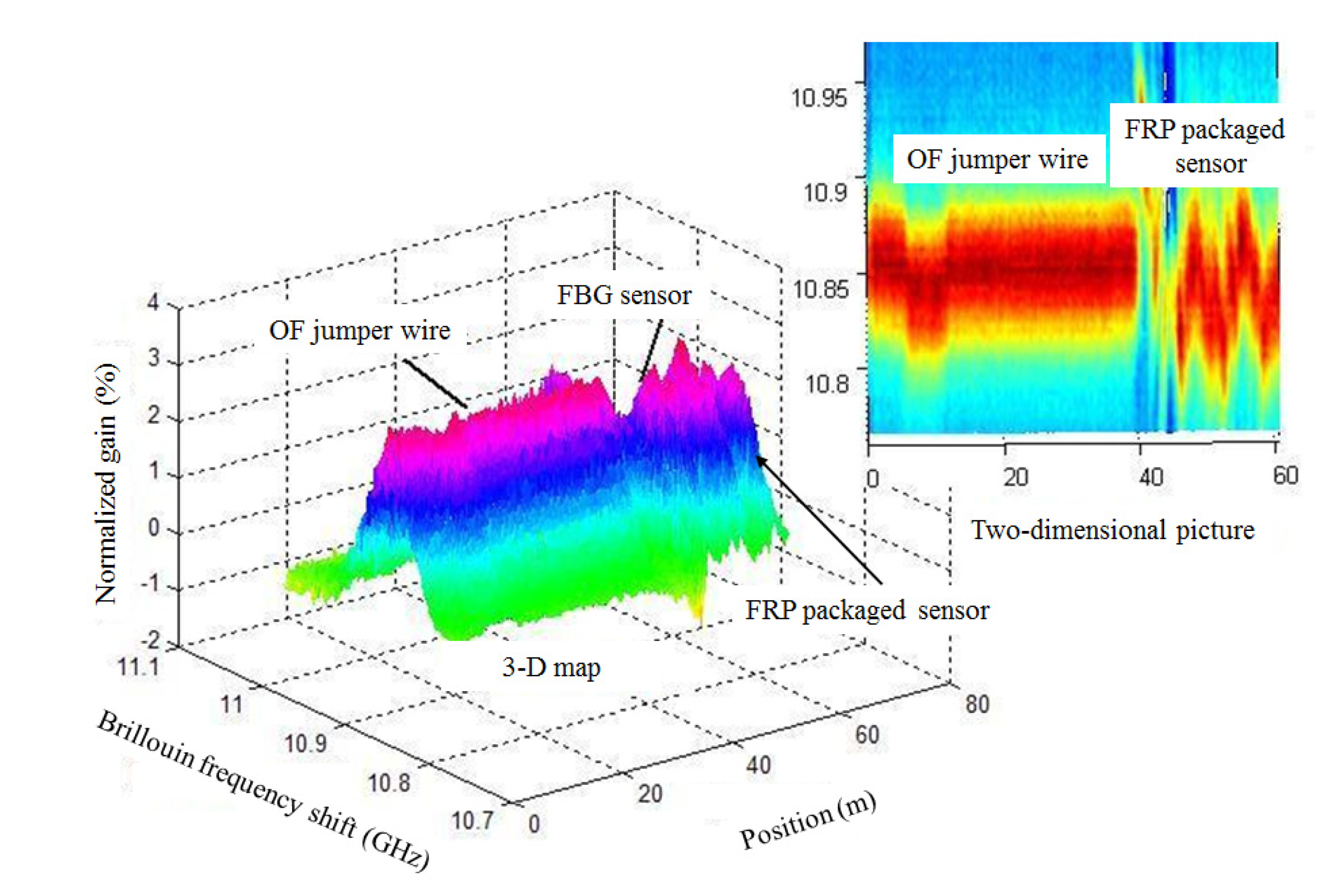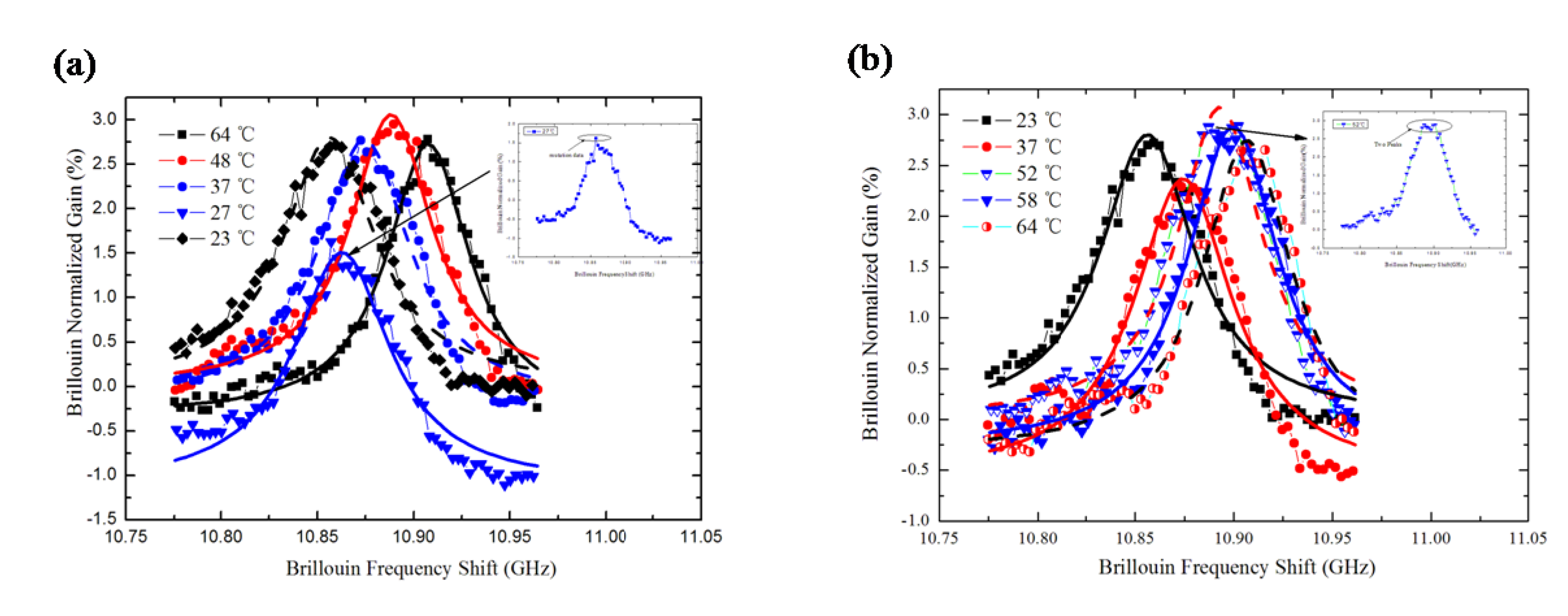Measurement Improvement of Distributed Optical Fiber Sensor via Lorenz Local Single Peak Fitting Algorithm
Abstract
:1. Introduction
2. The Introduction of the Lorenz Local Single Peak Fitting Algorithm
3. Investigation of Lorenz Local Single Peak Fitting Algorithm to Enhance Bfs Accuracy
3.1. ValidityTest of Lorenz Local Single Peak Fitting Algorithm Based on FRP Packaged Optical Fiber Sensor
3.2. Test Results and Analysis
4. Conclusions
Author Contributions
Funding
Institutional Review Board Statement
Informed Consent Statement
Data Availability Statement
Conflicts of Interest
References
- Xu, J.; He, J.; Zhang, L. Collapse prediction of karst sinkhole via distributed Brillouin optical fiber sensor. Measurement 2017, 100, 68–71. [Google Scholar] [CrossRef]
- He, J.; Xue, Y.; Xu, J.; Zhang, D.; Zhang, S. Whole-process monitoring of sinkhole collapse based on distributed optical fiber strain-vibration joint system and its case study in railway subgrade. Opt. Fiber Technol. 2020, 60, 102380. [Google Scholar] [CrossRef]
- Zhang, S.; Liu, B.; He, J. Pipeline deformation monitoring using distributed fiber optical sensor. Measurement 2019, 133, 208–213. [Google Scholar] [CrossRef]
- He, J.P.; Li, P.G.; Zhang, S.H. Continuous deformation measurement for track based on distributed optical fiber sensor. Struct. Monit. Maint. 2020, 7, 1–12. [Google Scholar]
- Hou, G.Y.; Li, Z.X.; Hu, T. Study on monitoring error of distributed optical fiber using fixed-point layout for tunnel deformation monitoring. Rock Soil Mech. 2020, 41, 3481–3490. [Google Scholar]
- Xu, Z.; Feng, X.; Zhong, S.; Wu, W. Surface Crack Detection in Prestressed Concrete Cylinder Pipes Using BOTDA Strain Sensors. Math. Probl. Eng. 2017, 2017, 1–12. [Google Scholar] [CrossRef] [Green Version]
- Coscetta, A.; Minardo, A.; Zeni, L. Distributed Dynamic Strain Sensing Based on Brillouin Scattering in Optical Fibers. Sensors 2020, 20, 5629. [Google Scholar] [CrossRef] [PubMed]
- Ismail, D.S.A.; Kassim, A. Monitoring of Deformation Behaviour of Unsaturated Soil Slope using Distributed Optical Fibre Sensor. Int. J. Integr. Eng. 2020, 12. [Google Scholar] [CrossRef]
- Shimizu, K.; Horiguchi, T.; Koyamada, Y.; Kurashima, T. Coherent self-heterodyne Brillouin OTDR for measurement of Brillouin frequency shift distribution in optical fibers. J. Light. Technol. 1994, 12, 730–736. [Google Scholar] [CrossRef]
- Kee, H.H.; Lees, G.P.; Newson, T.P. All-fiber system for simultaneous interrogation of distributed strain and temperature sensing by spontaneous Brillouin scattering. Opt. Lett. 2000, 25, 695–697. [Google Scholar] [CrossRef]
- Ravet, F.; Bao, X.Y.; Chen, L. Effect of pulse-width on strain measurement accuracy in Brillouin-scattering-based fiber optic sensors. SPIE 2004, 5579, 187–194. [Google Scholar]
- Kishida, K.; Li, C.-H.; Nishiguchi, K. Pulse pre-pump method for cm-order spatial resolution of BOTDA. In Proceedings of the 17th International Conference on Optical Fibre Sensors, Bruges, Belgium, 1–2 May 2005; pp. 559–562. [Google Scholar]
- Zhao, M.; Yi, X.; Zhang, J.; Lin, C. PPP-BOTDA Distributed Optical Fiber Sensing Technology and Its Application to the Baishuihe Landslide. Front. Earth Sci. 2021, 9, 281. [Google Scholar] [CrossRef]
- Chai, J.; Ma, Z.; Zhang, D.D.; Yuan, Q.; Lei, W. Experimental study on PPP-BOTDA distributed measurement and analysis of mining overburden key movement characteristics. Opt. Fiber. Technol. 2020, 56, 102175. [Google Scholar] [CrossRef]
- Liu, Q.; Chai, J.; Chen, S.J.; Zhang, D.D.; Yuan, Q.; Wang, S. Monitoring and correction of the stress in an anchor bolt based on pulse pre-pumped Brillouin optical time domain Analysis. Energy Sci. Eng. 2020, 8, 2011–2023. [Google Scholar] [CrossRef]
- Liang, H.; Zhang, X.P.; Li, X.H. Design and implementation of data fitting algorithm for Brillouin back scattered-light spectrum data. Acta. Photon. Sin. 2009, 38, 875–879. [Google Scholar]
- Nie, T.Y.; Li, J.Q.; Ding, Y.J.; Zhang, Z.; Dong, W. Fast extraction for Brillouin frequency shift in BOTDA system. Opt. Quant. Electr. 2021, 53, 73. [Google Scholar] [CrossRef]
- Azad, A.K.; Wang, L.; Guo, N.; Chao, T.H.Y. Signal processing using artificial neural network for BOTDA sensor system. Opt. Express 2016, 24, 6769–6782. [Google Scholar] [CrossRef] [PubMed]
- Demerchant, M.D. Distributed Strain Sensing for Civil Engineering Applications. Ph.D. Thesis, University of New Brunswick, New Brunswick, NB, Canada, June 2001. [Google Scholar]
- Shang, Q.-F.; Liu, J.; Li, Y.-Q. Influence of Temperature Gradient on Measurement Accuracy of BOTDR System. In Proceedings of the 2009 International Workshop on Intelligent Systems and Applications, Wuhan, China, 23–24 May 2009. [Google Scholar] [CrossRef]
- Zhou, Z.; He, J.; Ou, J. Integrated Optical Fiber Sensing System by Combing Large-Scale Distributed BOTDA/R and Localized FBGs. Int. J. Distrib. Sens. Networks 2012, 8, 804394. [Google Scholar] [CrossRef]






| Loading Rule | Temperature (°C) | ||||
|---|---|---|---|---|---|
| Heatingup | 23 | 34 | 52 | 58 | 64 |
| Coolingdown | 64 | 48 | 37 | 27 | 23 |
Publisher’s Note: MDPI stays neutral with regard to jurisdictional claims in published maps and institutional affiliations. |
© 2021 by the authors. Licensee MDPI, Basel, Switzerland. This article is an open access article distributed under the terms and conditions of the Creative Commons Attribution (CC BY) license (https://creativecommons.org/licenses/by/4.0/).
Share and Cite
Liu, B.; He, J.; Zhang, S.; Zhang, Y.; Yu, J.; Wang, X. Measurement Improvement of Distributed Optical Fiber Sensor via Lorenz Local Single Peak Fitting Algorithm. Symmetry 2021, 13, 1166. https://doi.org/10.3390/sym13071166
Liu B, He J, Zhang S, Zhang Y, Yu J, Wang X. Measurement Improvement of Distributed Optical Fiber Sensor via Lorenz Local Single Peak Fitting Algorithm. Symmetry. 2021; 13(7):1166. https://doi.org/10.3390/sym13071166
Chicago/Turabian StyleLiu, Bin, Jianping He, Shihai Zhang, Yinping Zhang, Jianan Yu, and Xiaoxue Wang. 2021. "Measurement Improvement of Distributed Optical Fiber Sensor via Lorenz Local Single Peak Fitting Algorithm" Symmetry 13, no. 7: 1166. https://doi.org/10.3390/sym13071166
APA StyleLiu, B., He, J., Zhang, S., Zhang, Y., Yu, J., & Wang, X. (2021). Measurement Improvement of Distributed Optical Fiber Sensor via Lorenz Local Single Peak Fitting Algorithm. Symmetry, 13(7), 1166. https://doi.org/10.3390/sym13071166






